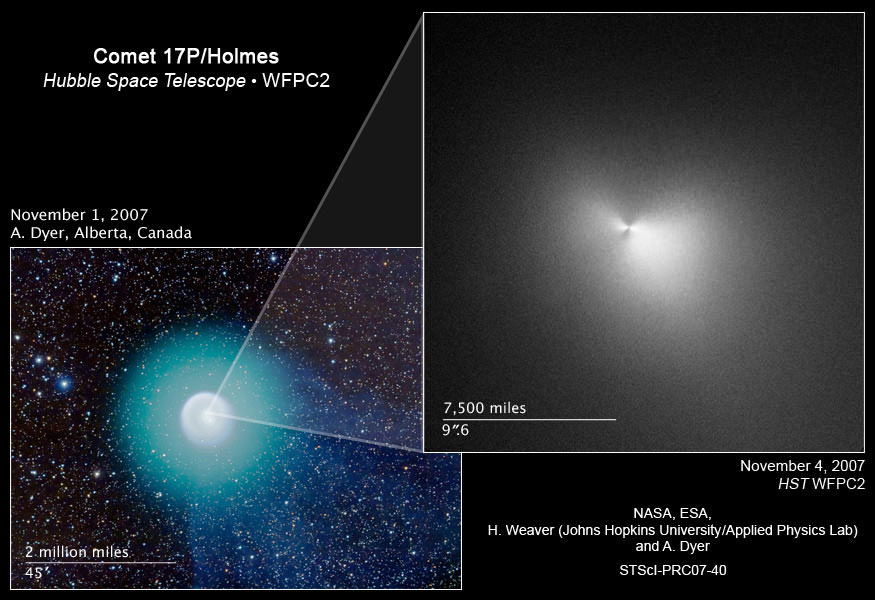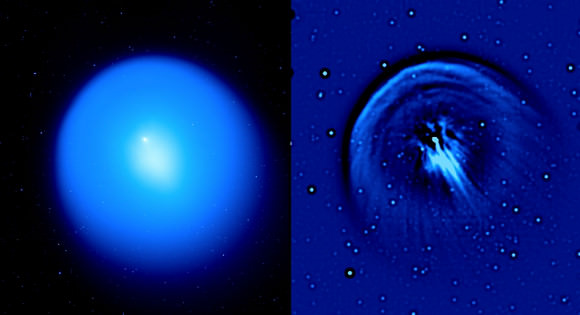[/caption]
Comet 17P/Holmes caused a sensation in October and November 2007 when overnight, it brightened enough to be visible with the naked eye and became the largest cometary outburst ever witnessed. Using a special filter on the Canada- France- Hawaii Telescope in Hawaii, astronomers were able to peer inside Comet Holmes to determine why the comet became so bright. Images and animations show multiple fragments were ejected and rapidly flew away from the nucleus of comet Holmes.
Astronomers Rachel Stevenson, Jan Kleyna and David Jewitt began observing comet Holmes in October 2007 soon after it was reported that the small (3.6 km wide) body had brightened by a million times in less than a day. They continued observing for several weeks after the outburst and watched as the dust cloud ejected by the comet grew to be larger than the Sun.

The astronomers examined a sequence of images taken over nine nights in November 2007 using a Laplacian filter which enhances sharp discontinuities within images. It is particularly good at picking out faint small-scale features that would otherwise remain undetected against the bright background of the expanding comet. They found numerous small objects that moved radially away from the nucleus at speeds up to 125 meters per second (280 mph). These objects were too bright to simply be bare rocks, but instead were more like mini-comets creating their own dust clouds as the ice sublimated from their surfaces.
“Initially we thought this comet was unique simply because of the scale of the outburst,” said Stevenson. “But we soon realized that the aftermath of the outburst showed unusual features, such as these fast-moving fragments, that have not been detected around other comets.”
While cometary outbursts are common, their causes are unknown. One possibility is that internal pressure built up as the comet moved closer to the Sun and sub-surface ices evaporated. The pressure eventually became too great and part of the surface broke away, releasing a huge cloud of dust and gas, as well as larger fragments.
Surprisingly, the solid nucleus of comet Holmes survived the outburst and continued on its orbit, seemingly unperturbed. Holmes takes approximately 6 years to circle the Sun, and travels between the inner edge of the asteroid belt to beyond Jupiter. The comet is now moving away from the Sun but will return to its closest approach to the Sun in 2014, when astronomers will examine it for signs of further outbursts.
The team presented their findings at the European Planetary Science Congress in Potsdam, Germany.
Lead image caption: (Left) Image of comet Holmes from the 3.6-meter Canada-France-Hawaii telescope on Mauna Kea showing the large expanding dust coma. On the left, a ‘raw’ image is shown, in which the brightness reflects the distribution of dust in the coma of the comet (the nucleus is in the bright, point-like region to the upper left of center). On the right is shown the same image after application of the Laplacian spatial filter, to emphasize fine structures. The white/black circular objects are background stars enhanced by the Laplacian filter.
Source: Europlanet


Comet Holmes was so incredible…. and now looks like a high speed impact event?
I reacted to this, because the wording implies [to this non-english speaker] that it was a physical filter applied to the telescope, when chances are that it is an algorithmic filter applied to the image.
Googling “Laplacian spatial filter” I find plenty of algorithmic ones. The top hit was this description on how to combine a gaussian and a laplacian kernel to smooth an image sufficiently on the spatial scale before letting the 2nd derivative laplacian approximation bring out edges.
Maybe you can do this directly in hardware somehow, but why would one go to such expenses?
The First Image is very interesting. If anyone is wondering what the special Laplacian filter is have a gander here:
http://tinyurl.com/nqjyjn
I understand its often used in Microscopy as well.
Its interesting to see the Bow shock defined as well. There was a lot going on inside the cloud. Its a shame that this is still the best we could do in terms of raw imagery.
The thing that I’m wondering about, is where and if it accumulates the materials to put on this show. We know its done this before. We also know the Core survived. So does it have enough material to keep doing this indefinitely or is it reaching a critical point where its accumulated (ice?) will run out?
Oner day our kids will chase these solar objects for fun I imagine / hope.
Damian
Although Comet Holmes was spectacular for us as astronomers it did not get the public interest it deserved. The reason was that we could not answer the basic question – What is going on here? Many thanks to the astronomers who provided the understanding. It is true that Holmes performed in a similar way before, in 1892 when it was close to M31. It gave the appearance in photographs of a companion galaxy
Hopi Blue Star Prophecy
‘end of time’ window 2007-2015